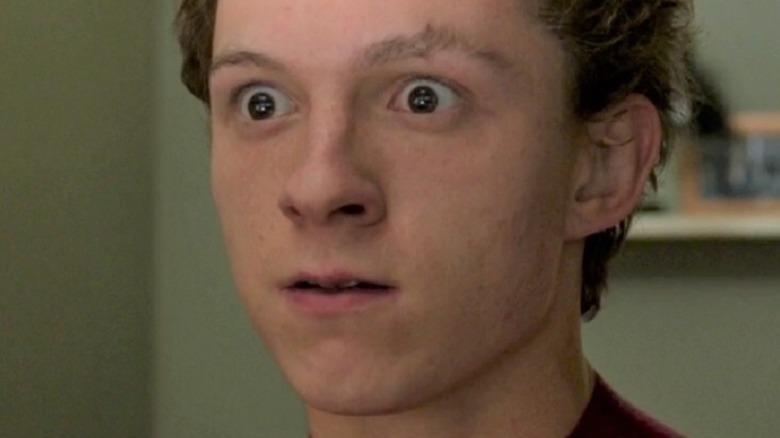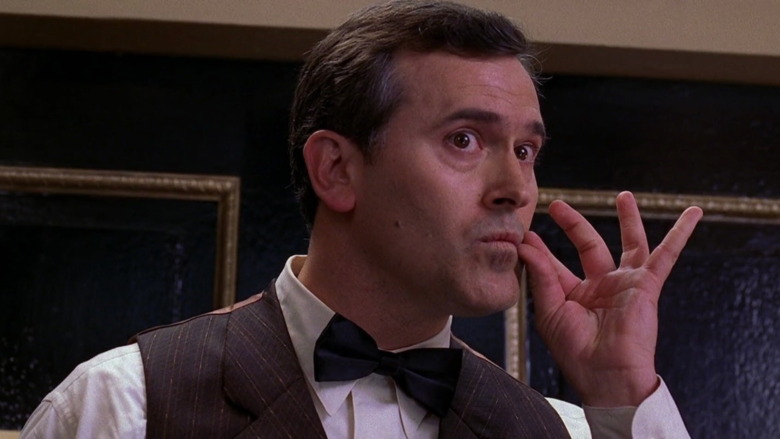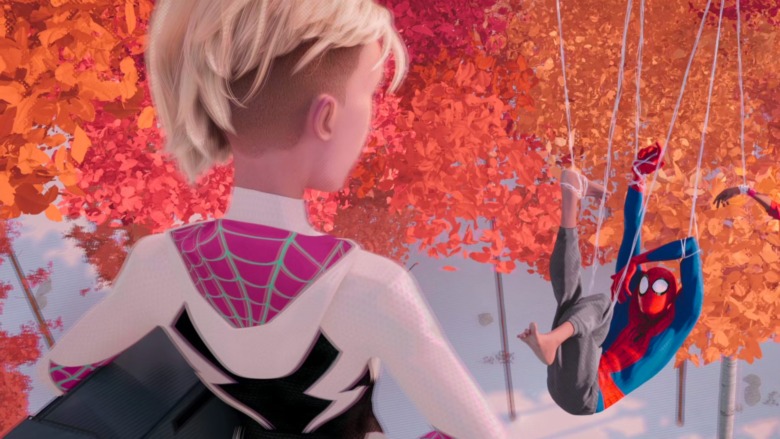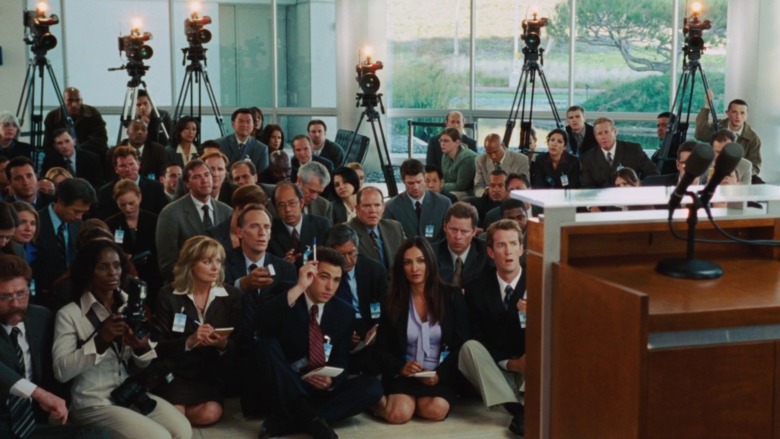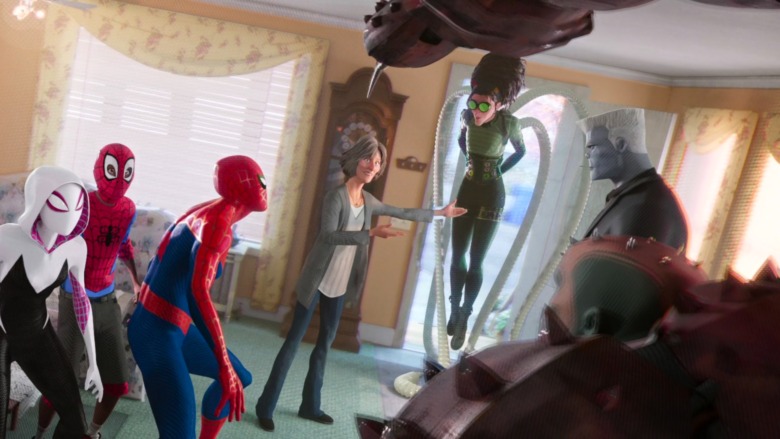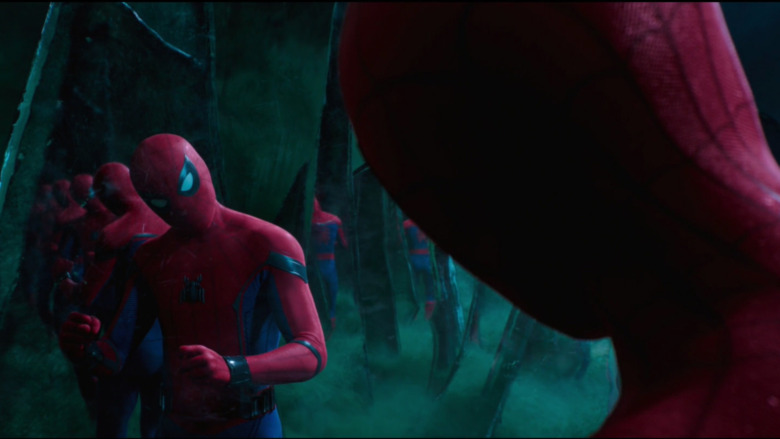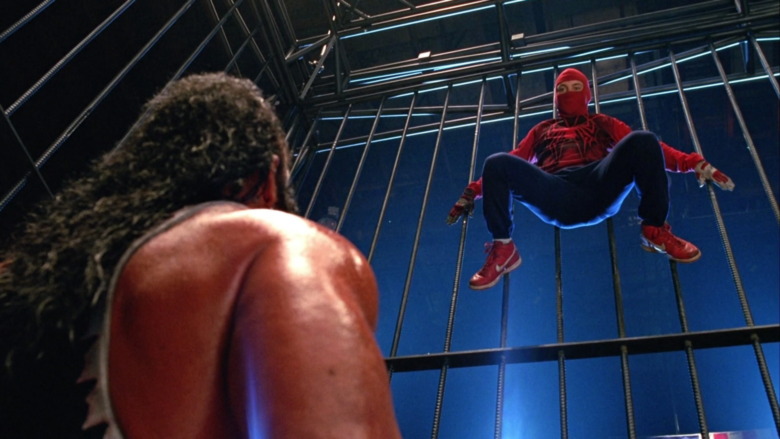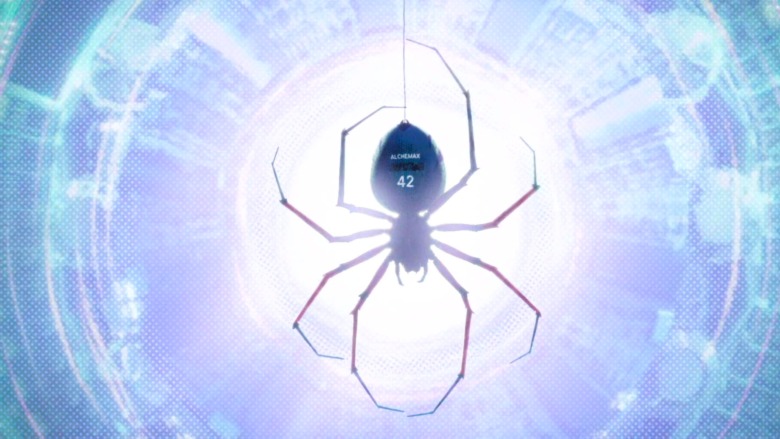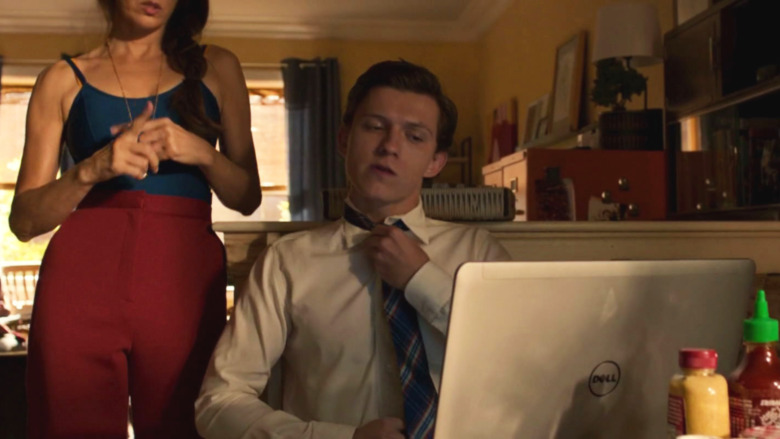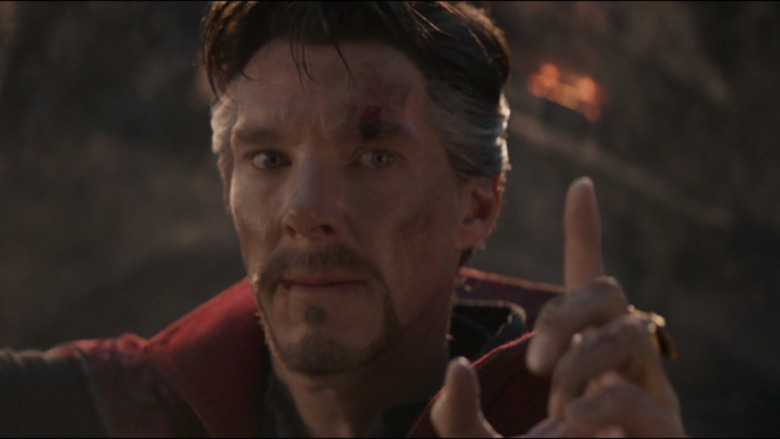Spider-Man Movie Theories That Change Everything
Spider-Man has a cinematic legacy that few comic book characters can match. Various versions of this wall-crawling superhero have shown up in a whopping 11 theatrical films over the past two decades. And although he's been recast and rebooted numerous times, the character's popularity has remained remarkably consistent with countless die-hard fans all around the world.
And as is often the case whenever there are legions of fans that absolutely love a film franchise, Spider-Man fans have concocted a wide array of wacky theories about what's really going on in these seemingly straightforward action movies. Usually, these theories are made mostly seriously. A fan will latch onto some sort of puzzling line of dialogue or enigmatic supporting character and come up with a completely wild — but nonetheless compelling — explanation in order to justify this plot element's existence. Other times, though, it's just fans having fun, inventing offbeat interpretations of their favorite stories in order to make each other laugh.
Today, we're running down all the most popular fan theories about "Spider-Man" movies. Though there are countless theories out we could've chosen, these are the ones that keep popping up on social media and in our own personal lives over and over again. Some of these fan theories are surprisingly plausible and may legitimately change the way you view these movies. Others are just total off-the-wall nonsense, but nonetheless, all of them are fun to talk about and fun to keep in mind when you watch these films.
Bruce Campbell is Mysterio
Actor Bruce Campbell appears in all three of Sam Raimi's "Spider-Man" films in minor supporting roles. In the first film, he's a professional wrestling announcer. In the second, he's the usher at a theater where Mary Jane is performing. In the third, he's a maitre d' at a fancy restaurant. Some fans have theorized that these three characters are actually all the same person, the villain Quentin Blake, aka Mysterio, who's secretly observing Spider-Man in order to better understand his foe while also sabotaging him in subtle ways.
Although Campbell has denied that there was ever any intention to for him to actually play Mysterio, there's also some surprisingly credible evidence that this may have once been a direction that the filmmakers were considering. Artist Jeffrey Henderson was, at one point, hired to work on some early storyboards for what would've been Raimi's fourth "Spider-Man" film before the project was later abandoned. He still has quite a few storyboards from this project up on his website, and one of them shows a man dressed in Mysterio's classic outfit and bearing a striking resemblance to Bruce Campbell.
Although this popular theory has never officially been confirmed, the comic "Ultimate Spider-Man" did included a nod to it. In one issue, Spidey visits the set of a "Spider-Man" movie that's being directed by Sam Raimi. After a scene finishes shooting, Raimi refers to the actor playing Mysterio as "Bruce."
Peter B. Parker never knew a Gwen Stacy
In "Spider-Man: Into the Spider-Verse," we meet a variety of Spider-People from various alternate dimensions, each a slightly different take on the character. One such character is Peter B. Parker, who's presented as basically the standard comic book version of the character, albeit one who's a tad older and sadder than usual. In fact, when we see Peter B. Parker's home dimension displayed on a computer screen, it's even labeled as Earth-616, the designation typically given to the core continuity version of Earth in Marvel comics. However, due to a strange detail that can be observed in this character's behavior, some fans have theorized that this version of Peter Parker must actually come from a reality that's quite different from the original comics.
You see, in the classic "Spider-Man" comics, Spidey's first girlfriend is not Mary Jane but a woman named Gwen Stacy. However, early on in their relationship, Gwen is kidnapped by the Green Goblin, and Spider-Man ends up inadvertently causing her death while trying to rescue her. "Spider-Verse" introduces us to a new take on Gwen Stacy from another world. In this other reality, Gwen Stacy is the one who gets bitten by the radioactive spider, not Peter Parker.
Taking all this into consideration, you'd imagine that most versions of Peter Parker who suddenly encountered Gwen Stacy would be overcome with emotion. There she is, your dead girlfriend, now brought back to life and standing before you. But when Peter B. Parker first sees her, he seems completely unfazed. He doesn't even recognize her. So, despite how the film presents this character, it seems as though he must've come from a continuity that's quite a bit different from your typical Spider-Man origin story.
Uncle Ben is in the first Iron Man movie
Although Spider-Man made his official Marvel Cinematic Universe debut during "Captain America: Civil War," some attentive film fans have speculated that there might actually be a hint towards the existence of Spider-Man in a much earlier MCU film — the very first MCU film, in fact. In 2008's "Iron Man," after Tony Stark escapes from the cave where the Ten Rings were imprisoning him, he returns to America and gives a press conference. During this scene, he addresses one of the reporters as "Ben" with a tinge of familiarity in his voice. Now this might not mean anything at all, but if you want to put on your tin foil hat for a minute, assume that this "Ben" is actually Ben Parker, aka Uncle Ben.
Think about it, we know that Peter Parker grows up to be a reporter. We also know that Peter looked up to his Uncle Ben immensely, so it wouldn't be that big of a stretch to think that Ben himself might have also been a reporter. Also, if Tony Stark was acquainted with Ben prior to his death, that might also help to explain how he became aware of Peter's secret identity and why he decided to step in and become involved in Peter's life.
To be fair, there's also another possible explanation as to who "Ben" might be. There's a prominent investigative journalist character in the "Daredevil" comics by the name of Ben Urich, and he's actually appeared on-screen twice already, once in the 2003 "Daredevil" film, played by Joe Pantoliano, and once in the "Daredevil" Netflix series, played by Vondie Curtis-Hall. Or, y'know, it could also just be some other guy named Ben. It's a pretty common name.
Aunt May and Doc Ock are exes
Although "Spider-Man: Into the Spider-Verse" is full of fun and surprising moments, perhaps the coolest and most unexpected twist of all occurs when we discover that a seemingly minor character in the film — a frazzled female scientist who works for the Kingpin — is revealed to actually be Olivia Octavius, this universe's version of the supervillain Dr. Octopus. After her identity is revealed, though, Dr. Octopus clarifies, "My friends actually call me Liv." At first, this line just seems to be a throwaway joke, but a later bit of dialogue has caused some fans to develop quite an exciting theory about this new take on the character.
You see, later in the film, our heroes get into a fight with a team of supervillains inside Aunt May's home. When Doc Ock enters the room, May comments, "Oh great, it's Liv." But as previously established, only Dr. Octopus' friends call her Liv. So do these two have some sort of history?
If the backstory of this world is anything like the "Spider-Man" comics, then the answer is absolutely "yes." The comic book versions of Aunt May and Dr. Octopus were once involved in a brief romantic relationship, and they almost even got married. Based on that, it's really not too big of a stretch to read the "Spider-Verse" versions of Aunt May and Doc Ock as bitter exes, and doing so adds an entirely new and exciting dynamic to their characters. Making this theory even sweeter is the fact that Lily Tomlin, the woman who played Aunt May in the film, is a queer woman herself in real life. Okay, we're calling this one. This isn't just a fan theory. As far as we're concerned, it's canon.
Spider-Man is a clone
The vast majority of Marvel films adapt their plotlines, in part or in full, from pre-existing comic book storylines. And though many of Spidey's most famous comic book adventures have already been adapted to film, there's one major chapter in Peter's life that the film's haven't yet touched at all — the Clone Saga. Because of this, some fans have speculated that the chances are pretty good that Marvel Studios will eventually adapt this story, and if that happens, they just might drop one heck of a plot twist on us — that friendly neighborhood Spider-Man that we've all come to love might not be Peter Parker at all. He might be a clone.
The plot of the original Clone Saga revolves around Peter Parker discovering that there are numerous clones of himself that have been created by a supervillain named the Jackal. Some of them are evil, like the villainous Kaine and Spidercide, and some are good, like the heroic Scarlet Spider. Making matters worse, Peter has to grapple with the fact that he himself might also be a clone, implanted with fake memories, and not the original Peter Parker.
As long as Spider-Man remains popular, we're going to keep getting "Spider-Man" movies, so it's almost inevitable that, at some point, we're going to see some version of the Clone Saga on the big screen. And when that happens, Marvel just might reveal that Tom Holland's Spider-Man might not be the original Peter Parker at all. For what it's worth, Holland himself has stated that he would be very interested in making a movie version of the Clone Saga, saying (via Cinema Blend), "It would be so cool. ... I could play seven characters." And you know what, Tom, we agree. That would be cool.
Peter Parker doesn't know that pro wrestling is fake
One of the funniest and memorable scenes in Sam Raimi's first "Spider-Man" film occurs when Peter Parker, newly endowed with spider powers, decides to try to use his abilities to earn some money in the world of professional wrestling. His task? Survive for three minutes in a cage with the terrifying Bone Saw McGraw, played by pro wrestler Randy Savage. There's just one problem with this scene that the film never addresses — in the real world, professional wrestling is fake.
There are two ways to rectify this potential problem. First, you can accept the film on its own terms. In the world of "Spider-Man," either all pro wrestling is real or, at the very least, this particular wrestling event is real, and Peter really is in danger. But there's also another option. What if Bone Saw's tough guy persona is all an act? What if he has no intention of hurting Peter whatsoever, but Peter doesn't know that because Peter thinks that pro wrestling is real?
Not only does this interpretation totally track with the events of the film, but it also helps to explain a potential inconsistency in the movie. You see, during Peter's earlier fight with Flash Thompson, we see that when someone tries to attack Peter, it triggers his Spider-Sense, which seemingly slows down his perception of time and allows him to dodge more easily. However, when Bone Saw swings a folding chair at Peter, we get no slow motion, Peter seemingly can't dodge in time, and the chair hits him. If Peter's Spider-Sense triggers whenever he is in danger, what if it doesn't trigger around Bone Saw because it knows something that Peter himself does not — that Bone Saw isn't actually a threat.
The spider that bites Miles Morales is from our Earth
In Spider-Man: Into the Spider-Verse, we meet a variety of different Spider-People from different dimensions, and the vast majority of them were bitten by a radioactive spider native to their own dimension. In Miles Morales' home dimension, for instance, the person the spider bites is Peter Parker, specifically the blonde version of Peter Parker who is later killed by the Kingpin. But Miles himself is an exception to this rule. Miles gets his powers from a spider that came through the dimensional portal, a spider from another dimension. Thus, it stands to reason that, somewhere out there in the multiverse, there is a dimension that lost its radioactive spider, and thus a dimension that never got its Spider-Man. But which dimension is this?
Some fans who decided to have a bit of fun with this idea put forth a truly wild theory, the idea that the world that Miles' spider came from is, in fact, *our* world, the actual real life planet Earth. If you think about it, it kind of actually makes a weird kind of sense. After all, we never had an actual Spider-Man in the real world, and now we know why. Thanks a lot, Miles.
The MCU Spider-Man is a trans boy
One of the most popular types of fan theories among Marvel fans — especially LGBTQIA+ Marvel fans — are queer headcanons. Headcanons are ideas that aren't explicitly true in a given story, but they're things that fans would like to be true and thus have fun imagining. Since Marvel hasn't included any explicitly trans characters in its films so far, if someone wants to watch a movie about a trans superhero, their only option for now is to imagine a trans headcanon for an existing character. And no character in the MCU is more ripe for a trans headcanon than Spider-Man.
Let's run down the evidence that Peter Parker could be a transgender boy. In "Homecoming," Peter is shorter than the rest of his friends, including his female love interest, Liz. When Peter is getting ready for a date, he seems wildly unfamiliar with putting on cologne or wearing a tie, almost like he's never done these things before. Flash Thompson's favorite insult for Peter is "Penis Parker," a name which could have transphobic connotations. Also, Ned asks Peter, "Do you lay eggs?" However, only female spiders lay eggs. And finally, when the character of Aaron Davis comments that Peter has a girly voice, Peter gets extremely defensive, saying, "I'm not a girl!" Trans fans everywhere can relate to the painful experience of being misgendered based on the sound of your voice.
All of these events could be just attributed to normal teenage awkwardness, but they gain an additional layer of poignancy if they're happening to a newly out trans boy attempting to navigate the strange and unfamiliar world of masculinity. This reading is obviously not something the creators intended, but it's nonetheless a fun thing to consider when you watch the film.
Dr. Strange is only in Spider-Man: No Way Home in order to keep Tom Holland quiet
Tom Holland has a bad habit of accidentally spoiling plot elements from films that he's in whenever he's being interviewed. During the press tour for "Avengers: Endgame," Marvel came up with an almost foolproof solution to this problem — have him do interviews alongside Benedict Cumberbatch.
Unlike Holland, Cumberbatch is excellent at keeping his mouth shut when it comes to information about unreleased Marvel projects. Not only that, but he's also quite skilled at sensing whenever Holland is about to give something away and cutting him off. Given how fond Marvel seems to be of pairing these two together whenever they're promoting a project, is it possible that the only reason they decided to include Dr. Strange in "Spider-Man: No Way Home" is so that Benedict Cumberbatch would have a reason to tag along and babysit the film's loose-lipped star?
